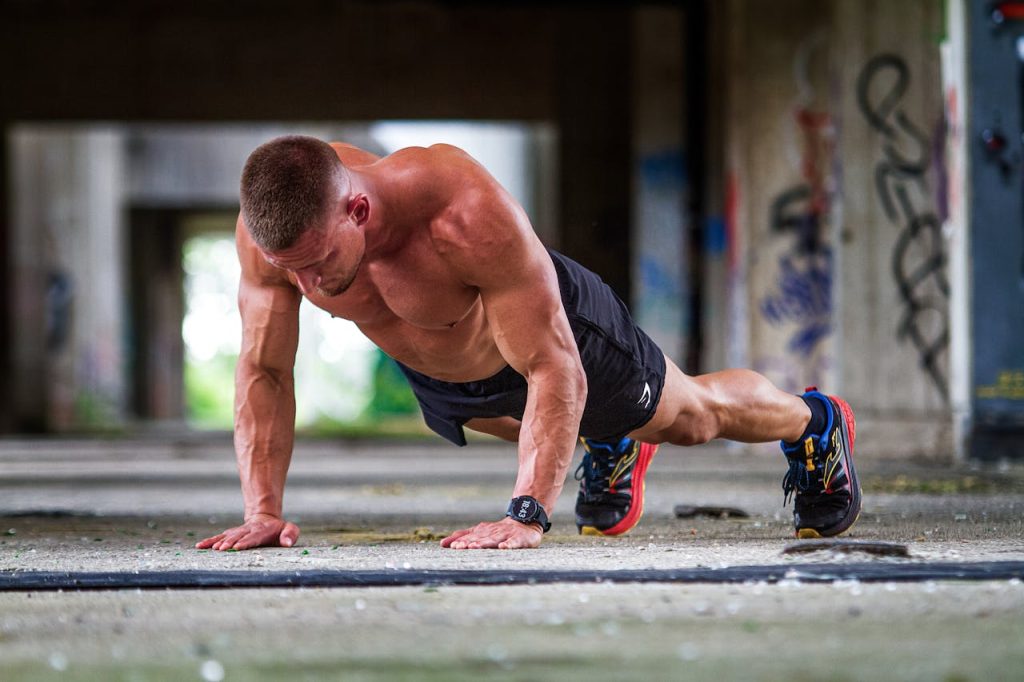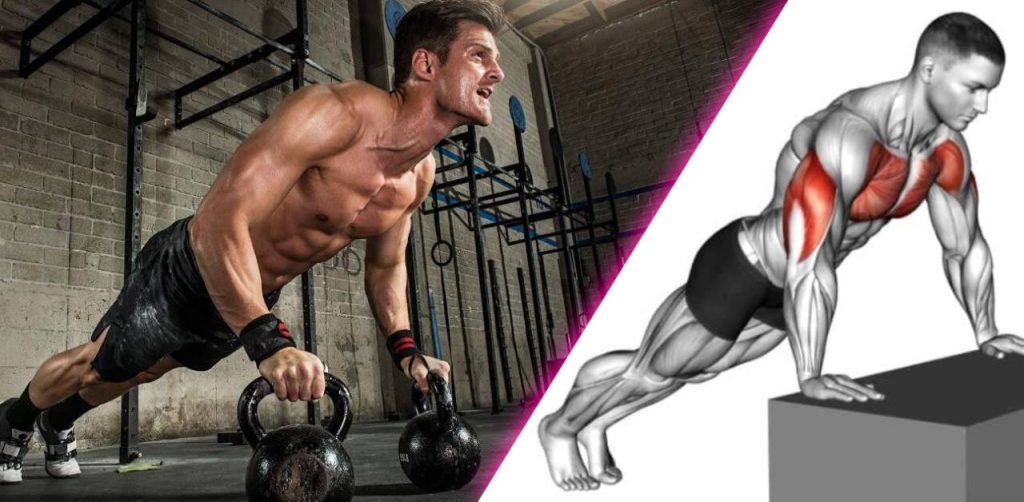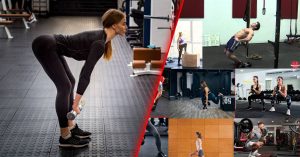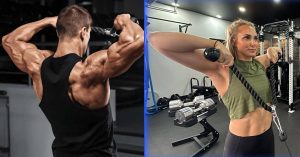Have you ever wondered why some people have that perfect chest shape, and how they achieve it without stepping into a gym? It’s not always about lifting heavy weights or having access to the latest equipment. Sometimes, the most effective tools are your own body weight and gravity. Particularly for the lower chest push-ups become an invaluable exercise.
When it comes to crafting a well-defined chest, the lower pecs often present the biggest hurdle. This area can be stubborn and may not respond to general chest exercises the way the upper and middle portions do.
However, with a strategic approach, you can target this tricky area effectively. Imagine being able to sculpt your lower chest, enhance its definition, and improve your overall physique—all from the comfort of your home. This isn’t just a dream; it’s a reality with the right push-up variations. So, find out the details in this guide!
Table of contents
MORE keyboard_double_arrow_down LESS keyboard_double_arrow_up
The Mechanics Behind Lower Chest Push-Ups
Lower chest push-ups are not your average push-ups. They’re designed to put more emphasis on the pectoralis major’s lower fibers, a key muscle group for chest aesthetics and function. But how exactly do these push-ups work their magic?
- By adjusting the angle of your body and using elevation, you can shift the focus directly to the lower chest. This is something traditional push-ups might not offer.
- Specific variations of push-ups increase muscle activation in the lower chest area, leading to better growth and definition.
The beauty of these exercises lies in their simplicity. No need for a gym membership or expensive equipment. All you need is a bit of space and your body weight.
The Unseen Benefits of Focusing on the Lower Chest
Beyond aesthetics, targeting the lower chest with push-ups offers a multitude of benefits. Not only do these exercises sculpt the chest, but they also:
- Enhance Overall Strength: Strengthening the lower chest contributes to better push-up performance and upper body strength.
- Improve Posture: Strong chest muscles support good posture by balancing the upper body’s muscular structure.
- Boost Functional Fitness: Activities of daily living, sports, and other exercises become easier with a strong lower chest.
Why Lower Chest Push-Ups Deserve Your Attention
Now, you might be thinking, “Are lower chest push-ups really worth it?” The answer is a resounding yes. These exercises offer a unique combination of benefits that are hard to achieve through other means.
Plus, the ability to perform them at home makes them a convenient option for anyone, regardless of fitness level. So, here is why lower chest push ups stand out:
Building Endurance
Imagine pushing through your limits, rep after rep, your muscles growing stronger with each movement. Lower chest push-ups are not just about the numbers; they’re about endurance. This endurance isn’t limited to your chest—it radiates through your entire body, empowering you to tackle more, do more, and be more.
Stability from the Core
Stability might not be the first thing you think of when you hear “push-ups,” but lower chest variations are a game-changer. They don’t just work your chest; they require a harmony of muscles to maintain balance. This isn’t just physical balance but a balance in muscle development, leading to a physique that’s not just strong but symmetrically so.
Sculpting the Perfect Chest
Everyone wants to look their best, and a well-defined chest is often a key part of that image. Through the strategic use of incline push-ups and other variations, you sculpt not just any chest, but one that captures attention.
Minimizing Injury Risks
In the pursuit of strength, the last thing anyone wants is to be sidelined by injury. Lower chest push-ups, with their focused intensity, help fortify the chest and protect against strains that can come from less targeted exercises. This protective benefit extends beyond the gym, supporting your everyday movements with strength and resilience.
Improved Heart Health
It’s easy to focus on the visible benefits of push-ups, but their impact goes deeper. Lower chest workouts are a cardiovascular booster, enhancing not just muscle but heart health. The result? A metabolism that’s revved up and ready, burning calories more efficiently and bolstering your overall fitness.
Home Workouts Redefined: Mastering Lower Chest Push-Ups

Incline Push-Ups
Incline push-ups is a different way to do regular push-ups. Instead of putting your hands flat on the ground, you put them on something higher, like a box, table, or bench. This makes the exercise a bit easier.
When you do Incline push-ups, you use your chest muscles, but you also work your arm and shoulder muscles.
Here’s how to do leaning push-ups:
- Stand facing the raised surface and put your hands shoulder-width apart on the edge. Straighten your arms without locking your elbows.
- Make your body straight from head to toe, like a plank. Keep your back and legs straight.
- Squeeze your chest muscles and slowly lower your chest towards the edge of the surface. Breathe in while you do this, and keep your elbows close to your sides.
- Hold for a few seconds at the bottom with your body still straight, then push yourself back up to the starting position. Breathe out as you push back up. Don’t lift your back or let your hips sag.
- Do 8 to 12 repetitions.
Clapping Push-Ups
Clapping push-ups are a challenging exercise that can help you:
- Build and tone your upper body: This includes your chest, shoulders, and triceps muscles.
- Improve shoulder stability: This can help prevent injuries and improve your posture.
- Increase body awareness: You’ll be more aware of your body position and how it moves.
- Before you try clapping push-ups, make sure you can comfortably do regular push-ups.
Here’s how to do clapping push-ups:
- Start in a regular push-up position: Hands shoulder-width apart, body in a straight line from head to toe.
- Lower yourself down: Bend your elbows and lower your chest towards the ground. Keep your core engaged and body straight.
- Push up explosively: As you reach the bottom, push yourself up with power, aiming to clap your hands together mid-air.
- Land softly: Land back on the ground in the starting position, keeping your body straight.
Tips:
- Start with fewer repetitions and gradually increase as you get stronger.
- Use an exercise mat for comfort if needed.
- Focus on explosive power rather than the clapping itself.
- If clapping is too challenging, try pushing up with a slight pause at the top instead.
- Clapping push-ups are a great way to challenge yourself and take your push-ups to the next level. Just be sure to listen to your body and progress at your own pace.
Feet Elevated Push-Ups
Here’s how to do feet-elevated push-Feet-elevated push-ups, also called decline push-ups, are a tougher version of the classic push-up. They target the chest muscles, particularly the upper pecs, more intensely than standard push-ups.
ups:
- Start in a high plank position: Place your hands flat on the ground, shoulder-width apart, arms straight, and body forming a straight line from head to heels.
- Elevate your feet: Find a stable platform, like a bench, box, or chair, and place your toes on the edge. The higher the platform, the harder the exercise.
- Lower your body: Bend your elbows and slowly lower your chest towards the ground, keeping your core engaged and body in a straight line.
- Push back up: Use your chest muscles to press yourself back to the starting position, exhaling as you exert force. Remember, maintain a straight body line throughout the movement.
- Repeat: Do as many repetitions as you can comfortably perform with good form.
Tips:
- Start with a lower platform height and gradually increase the difficulty as you get stronger.
- Focus on controlled movements, both lowering and pushing yourself up.
- If you struggle with full push-ups, try performing knee push-ups with your feet elevated.
- Listen to your body and avoid any pain or discomfort.
- Feet-elevated push-ups are a great way to add variety and challenge to your push-up routine, helping you build upper body strength and endurance. Remember to start at a manageable level and progress carefully to avoid injuries.
Reverse Grip Push-Ups
Reverse grip push-ups are a variation of the classic push-up that offers a unique challenge and targets different muscle groups. They are particularly effective for strengthening the shoulders, chest, and triceps.
Here’s how to do them:
- Start in a standard push-up position: Hands shoulder-width apart, body forming a straight line from head to heels.
- Rotate your hands: Unlike regular push-ups, turn your palms so your fingers point towards your feet. Keep your hands slightly wider than shoulder-width apart.
- Lower yourself down: Bend your elbows and slowly lower your chest towards the ground, keeping your core engaged and body in a straight line.
- Push back up: Use your chest and triceps to press yourself back to the starting position, exhaling as you exert force. Maintain a straight body line throughout the movement.
- Repeat: Do as many repetitions as you can comfortably perform with good form.
Tips:
- Start with fewer repetitions and gradually increase as you get stronger.
- Focus on controlled movements, both lowering and pushing yourself up.
- If the full push-up is too challenging, try performing them on your knees, or with feet elevated on a platform.
- Listen to your body and avoid any pain or discomfort.
- Reverse grip push-ups can be a great addition to your routine for building upper body strength and endurance, but remember to start at a manageable level and prioritize proper form to avoid injury.
Expert Insights on Lower Chest Push-Ups
Fitness gurus and seasoned trainers alike converge on a singular truth: incorporating push ups for lower chest into your workout routine, at least three times a week, can dramatically transform your chest’s appearance and strength. But why do experts put so much emphasis on these exercises, and how do they align with your fitness goals? Let’s find out.
Dr. Brad Schoenfeld is a renowned fitness expert with a Ph.D. in exercise science and multiple certifications, including Certified Strength and Conditioning Specialist (CSCS).
According to Dr. Schoenfeld lower chest push-ups can be an effective exercise for targeting the lower portion of the chest muscles due to the increased activation of the lower pecs when the hands are positioned closer together.
Furthermore, Jeff Cavaliere is a physical therapist, strength coach, and the founder of Athlean-X, a popular fitness brand known for its evidence-based training programs. Cavaliere often recommends variations like lower chest push-ups to diversify chest training routines and stimulate different areas of the pectoral muscles for balanced development.
Also, Bret Contreras, also known as “The Glute Guy,” holds a Ph.D. in Sports Science and is a leading authority in strength training and biomechanics.
Contreras acknowledges that lower chest push-ups can be beneficial for individuals looking to isolate and strengthen the lower chest region, especially when combined with other chest exercises to ensure overall muscle development.
Wrapping Up
Pushup lower chest emerge not just as exercises, but as pillars of a well-rounded fitness routine. Their impact, underscored by dedication and the correct execution, promises a chest that is not only sculpted but also functionally strong.
Embarking on this path with lower chest workout at home, guided by expert insights, armed with practical advice, and enlightened by debunking common myths, sets the stage for a transformative fitness journey. Are you ready to see where this journey takes you, and how far your dedication can push the boundaries of what you thought possible in chest development?
Key Points
- Adjusting your body with a raised surface engages the lower pectoral muscles more effectively.
- For isolating the lower chest, decline presses are superior, specifically targeting the sternal head of the pectoral muscles.
- Regular and consistent push-up exercises, including variations, contribute to a more defined and larger chest by working multiple muscle groups effectively.
- Lower chest push-ups, including incline, clapping, feet elevated, and reverse grip variations, can be performed at home without specialized equipment.
- Incorporating lower chest push-ups into your routine three times a week is recommended for noticeable chest development.
- Gradually increasing workout intensity while maintaining proper form ensures safety and effectiveness in building muscle strength and endurance.
- Besides targeting the lower chest, push-ups also enhance overall upper body strength, including shoulders and triceps, contributing to improved posture and functional fitness.
- Different push-up variations not only prevent workout monotony but also ensure all parts of the chest and related muscle groups are engaged and developed.
FAQs
Which Push-Ups Work Lower Chest?
Incline push-ups are particularly effective for targeting the lower chest. By positioning your hands on a raised surface, such as a barbell set at a low angle, and orienting your lower body downward, you create the perfect angle to engage the lower chest muscles preferentially.
This adjustment in angle focuses the effort on the lower pectorals, making incline push-ups a go-to exercise for lower chest development.
What Press is Best for Lower Chest?
For targeting the lower chest, decline pressing exercises are your best bet. Unlike incline pressing, which focuses on the upper pec muscle fibers, decline pressing targets the lower pec muscle fibers, specifically the sternal head.
Flat pressing exercises, like the bench press, will target the entire pectoral muscle, including both the sternal and clavicular parts, but for a focused lower chest workout, decline presses are most effective.
Do Push-Ups Build Chest Size?
Absolutely, push-ups can significantly contribute to building chest size. As a versatile exercise, push-ups target a wide range of muscles, with a particular focus on the chest. When performed consistently and with proper form, push-ups not only enhance muscle endurance and strength but also contribute to a more defined and chiseled chest appearance.
They are a powerful exercise that can be performed anywhere, requiring no equipment, making them a convenient option for chest development.
Can Lower Chest Push-Ups Be Done at Home?
Yes, lower chest push-ups can easily be incorporated into a home workout routine. Exercises such as incline push-ups, clapping push-ups, feet elevated push-ups, and reverse grip push-ups are all effective variations that can be performed at home to target the lower chest.
These variations require minimal to no equipment and can be adapted to suit any fitness level, making them a practical choice for those looking to enhance their lower chest development without the need for a gym membership.
How Often Should I Perform Lower Chest Push-Ups for Optimal Results?
Experts recommend incorporating lower chest push-ups into your workout routine at least three times a week for significant chest development. Consistency, along with proper form and gradually increasing intensity, is key to achieving visible results.
As with any exercise regimen, allowing time for muscle recovery is essential, so be sure to balance your push-up workouts with rest days.

ABOUT THE AUTHOR
Follow Valen Steven for a dose of fitness enthusiasm, evidence-based advice, and a roadmap to achieving your health and wellness goals.
Subscribe to our Newsletter
Dive into a world of fitness and wellness with our exclusive newsletter! Sign up now and receive weekly power-packs of fitness wisdom




